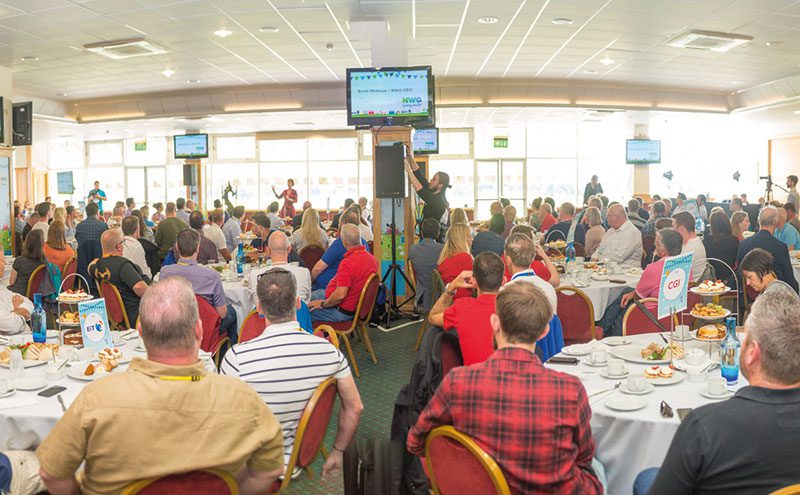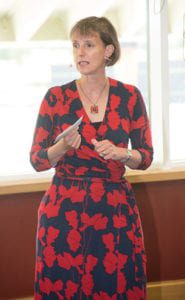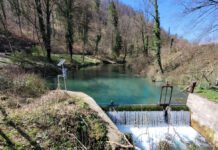Northumbrian Water held an Innovation Festival in July which brought together business leaders, customers and delegates from technology firms like IBM and Microsoft to brainstorm around issues like flooding, leakage and 21st century infrastructure.

The concept behind the NWG Innovation Festival seems a novel one. Carl Pheasey, Director of Strategy and Policy at water industry regulator OFWAT, said: “I think the idea is fantastic and it’s very timely, with the launch of PR19 this week.” The recent OFWAT price review puts a premium on innovation. So it’s a good time to be thinking about how ideas can be generated.

“There is definitely something about collaboration that is really important to doing innovation well.
“My limited experience of these sorts of processes in other sectors is that the really good ideas come out when you get people from very different backgrounds and frames of reference coming together and trying to take a fresh look at how to solve long-standing problems.”
Heidi Mottram, Chief Executive of Northumbrian Water, said: “The amount of time you spend tackling problems over the course of the year adds up to a lot of working hours. The NWG Innovation Festival has enabled us to achieve that in five days.
The following sessions ran at the event, included here with the ideas they generated:
‘Rain, Hail or Shine’: How can we reduce flooding?
Led by headline sponsor IBM
- Members of the public could work closely with relevant agencies and help keep communities informed, to reduce flood risk and ensure better support when it happens.
- An agency could be created that links directly with customers to give and receive bespoke information on flooding, helping to reduce flood risk.
- AI technology could be used to deliver bespoke flood information to users, so they are better informed about how to respond when problems occur.
‘Keep It Flowing’: What do we know about leakage from water pipes and how can we fix it?
Led by NWG, alongside a Microsoft-led Hackathon of data relating to leakage.
- One possibility is a system that will allow water companies to more closely monitor their networks of pipes, identifying deterioration and areas of risk before leaks happen.
- The use of mobile apps that allow members of the public to report leaks with greater accuracy, using geospatial technology.
- The hackathon event identified the potential for more collaboration with experts outside the sector, using the power of data to deliver a better customer service.
‘Preparing for the Future: How do we upgrade our infrastructure for the 21st Century?’
Led by headline sponsor Reece Innovation
- There could be greater sharing of information between businesses, to ensure that services can be delivered in a way that better suits customers, with particular focus on those members of the public who are vulnerable.
- Sensor mapping technology could be used to improve knowledge of the various bits of service infrastructure – whether gas, electricity or water – that lie beneath the ground.
- You could introduce a system where communities tell service providers what is important to them, improving and tailoring provision.
- You might introduce shared infrastructure corridors, allowing different businesses to use the same pipes for their services, improving information sharing and reducing the impact of maintenance upon the public.
‘Tomorrow’s World’: What will living and working look like in 2030?
Led by headline sponsor CGI
- Possibilities considered included a ‘life assistant’ that filters through the increasing volumes of information from places like email and social media, prioritising what is delivered to users and when.
- Infrastructure that allows people to work in the environment of their choosing, or a personalised workspace, without becoming detached from their team.
- A personalised artificial intelligence device to learn about the environments and schedules that best suit the wearer, adapting to their working practices accordingly.
- An artificially intelligent system that links with personal digital assistants, such as Alexa, Cortana and Siri, to liaise with service providers, such as plumbers or handymen, saving home owners’ from having to do so directly.
‘How Green is Your City?’: What can businesses do to improve the environment in the North East?
Led by headline sponsor Ordnance Survey
- Towns could install special ‘moss trees’, which absorb pollution. These would also help to reduce surface water that might enter sewers and contribute to flooding. This idea will be entered into Ordnance Survey’s Geovation
Challenge in October, where it will compete for funding. - A text message and app system that alerts people to opportunities to car share, work from home or an alternative location, and advise on time, money and carbon savings.
’21st Century Reach’: How can we optimise a mobile workforce for a complex network business?
Led by headline sponsor BT
- This session alighted on the idea of creating a single, integrated system that brings together all the information necessary for a particular job, from details of the work, the tools needed, recordings of the initial call from the customer, previous jobs at that location, and even training videos.






